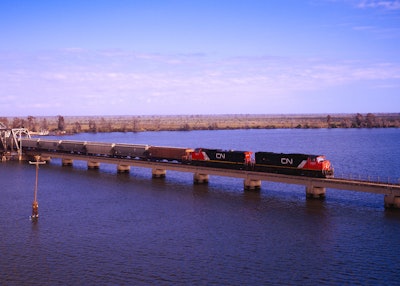
Every year, the Transportation Research Forum’s (TRF) annual conference convenes transportation practitioners, regulators and researchers of all modes.
These attendees discuss research, practices and technologies that affect public policy, enhance existing markets, and create new market opportunities.
Sessions cover rail, ocean, barge, and truck transportation, as well as port logistics, infrastructure investments and other areas.
Like many recent events, this year’s March 12-13 TRF conference was canceled because of coronavirus disease (COVID-19) concerns. Below, the preliminary results from three ongoing projects on agricultural transportation were digested in the latest USDA Grain Transportation Report.
These three papers were accepted for a special session, sponsored by USDA’s Agricultural Marketing Service.
Port Choice and International Trade in Agricultural Products
Exports are a key market for U.S. farmers and shippers. According to USDA’s Foreign Agricultural Service data, the United States exported almost 211 million metric tons of agricultural goods (worth $154 million) in 2019.
Various data on trade flows are available, such as values and volumes by commodity and port. What is less well known is how the U.S. ports are “selected” — that is, what factors explain why an importing country receives its product from one U.S. port versus another (e.g., one in the Gulf versus another in the Great Lakes).
In their paper, Tobias Sytsma and Wesley Wilson investigate the factors that influence port choice — why importers draw from one port rather than another. In the authors’ model, importers choose the port based on returns.
These returns depend on rates, distance to the destination, and port characteristics (channel depth and berthing length).
After developing their theoretical model, the authors use an empirical procedure to estimate the relationship between port volume shares and prices.
They find ports are highly competitive, where a 1% increase in price per ton at a particular port leads to a 5%t reduction in that port’s market share.
The authors also estimate the effects of port depth and berthing lengths on market share and find that increases in depth and longer berthing lengths lead to greater market share, as expected, but the size of the effects vary significantly across ports.
The results could be useful to policymakers looking to assess the effects of port investments across the country.
Exit Decisions in the Canadian Grain Elevator Industry
This paper, by Sichao Jiang, James Nolan, and Wesley Wilson, focuses on the Canadian grain elevator industry, an important link in the agricultural supply chain. Over the last few decades, the number of elevators has fallen dramatically.
The authors discuss the industry’s changing nature and examine the factors leading elevator owners to remain in or exit the market. In general, elevators are larger and built using more modern construction methods than they were 20 years ago.
The authors tailored their statistical analysis to account for each elevator’s reasons for exiting or remaining in the market. Because businesses tend not to operate at a loss in the long term, a choice to exit would indicate the business was not profitable.
Of the factors tested, rail loading capacity and number of nearby competitors were the most relevant to transportation.
More rail loading capacity increased the chances of an elevator remaining in the market. (In the analysis, this was expressed as a negative effect on the likelihood of exiting.)
A 1% increase in carloading capacity was associated with a 2.7% reduced likelihood of exiting the market.
This finding supports the assertion that transportation access is critical to the grain elevator industry’s profitability and to agricultural production in general.
Large numbers of competitors within a short distance (20-mile radius) negatively affected profitability, as indicated by an increased likelihood of exiting the market.
This suggests, over time, farmers within a given area will have access to fewer elevators.
While this will increase profitability for the remaining elevator, it can increase trucking transportation cost for the farmers if the closest elevator to their farms closed.
Costs, Scale Economies and Differential Pricing in the U.S. Railroad Industry
In the final paper, John Bitzan and Fecri Karanki of North Dakota State University analyze economies of density in the railroad industry (the extent to which there are cost savings from additional traffic over the existing railroad network).
They relate economies of density to ongoing regulatory issues surrounding rate reasonableness and revenue adequacy. In order to operate, railroads incur large fixed costs.
For instance, railroads must pay the costs of laying and maintaining track, regardless of how much volume they run over that track.
Moreover, as railroads run more volume of various commodities over that track, the average cost/ton declines, because those fixed costs are spread over more tons.
Economies of density in railroading stem from spreading these costs among more traffic over a fixed network and as a result of labor and equipment savings due to longer and more frequent trains.
The same reasoning is used to justify the need to charge different prices to different customers.
In charging a single price, railroads would likely go out of business for one of two reasons.
Staying in business means earning enough revenue. On the one hand, if the railroads charge a single price that is high enough to cover all their fixed costs, they risk being unable to compete with truck and barge in some markets.
In that case, their shipment volumes may not be high enough to earn adequate total revenue. On the other hand, if railroads charge a low enough price to maximize their shipment volumes, they will not earn enough in each individual transaction to recoup their total costs. Therefore, railroads charge different prices to different shippers depending on their willingness to pay (typically based on the shipper’s proximity to other transportation options).
This price structure enables them both to remain competitive and to earn enough revenues. The concern with differential pricing is that railroads may charge some shippers unreasonably high rates.
The authors argue a better understanding of railroad costs is needed in evaluating the merits of various alternatives to current rate regulation.
Some shippers believe the need for differential pricing has diminished over time, contending density economies have declined. However, Bitzan and Karanki argue a statistical model of railroad costs needs to be estimated to see if this is the case.
They estimate a cost model to see how economies of density have changed over time and how they relate to the need for differential pricing.
Bitzan and Karanki find economies of density in the rail industry persist, continuing to necessitate differential pricing, but they have declined somewhat over time.
If you would like more information on the working drafts submitted to TRF, please contact: [email protected], [email protected] or [email protected].
Information provided by the USDA Grain Transportation Report.

















